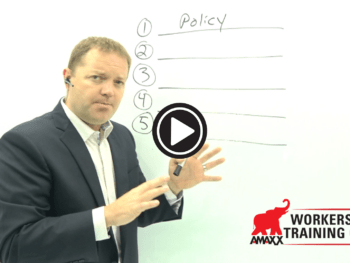Hey there. I’m Michael Stack, CEO of Amaxx and founder of the Amaxx Workers’ Comp Training Center. I grew up a Cubs fan in Valparaiso, Indiana, which is just outside of Chicago. While running a company, and with my wife, raising four kids, sitting down to watch a game very, very rarely makes the top of the priority list, except, of course, when they won the World Series last year. So I don’t have time to do that but I do want to know how well they’re doing. How well is their season going? So, every once in a while I’ll just slip over to ESPN and I’ll check the standings to give indication of how well the season is going and it gives me very comprehensive snapshot look. Turns out they just moved in to first place. So, their season, hopefully, seems to be on the right track.
This post is one in a 3-part series:
Snapshot Leading Indicator of Program Success
But, in baseball, just like in workers’ compensation, there are a million statistics that you can track and dive into the most minute detail, but how do you know in work comp how well your program is going? What is that comprehensive, leading indicator to let you know whether or not your program is on the right track?
Click Link to Access Free PDF Download
Return to Work Ratio
I want to introduce you to the return to work ratio and I’m gonna show you how to calculate it. Take a look at this board here. What you’re doing in this ratio is you’re tracking the number and the percentage of your injured workers that return to work within zero to four days. You are tracking the number and percentage of your injured workers that return to work in zero to four days. The best in-class programs will be at 95% or better. The best in-class programs will be at 95% of injured workers returning to work in zero to four days. So, let’s take a look very briefly at this quick example of how you track this and how you calculate it. You’re taking the injury date and you’re comparing it simply to the return to work date. How many days was that individual out of work? So, you can see here very simply on this example. Zero days, three, 20, 30 and 60.
Then here’s what you’re going to do with this next. Once you have the information then you graph it in Excel or a similar type program to visually represent in a snapshot, just like looking at the standings how well you’re doing. What you’re shooting for is 95% or better of your employees returning to work within zero to four days. Your programming when you graph it out and the best in-class program will look something like this, the graph that you represent. Where you might be right now is more like this. The vast majority of your employees are coming back to work in 30 days, 45 days, 60 days, 150 days. It doesn’t matter where you start, it’s a matter of understanding where you are, then you can analyze what are those factors that are causing that challenge and you can work to get just one employee back to work one day sooner. Little by little, little by little your graph starts to change from looking something like this, to something like this.
FREE DOWNLOAD: “5 Critical Metrics To Measure Workers’ Comp Success”
Most Comprehensive Leading Indicator Available
The return to work ratio, the most comprehensive indication of your program. It tracks things like how well you’re reporting your claims, how well are you getting your injured workers to the right medical treatment at the right time, how well are you getting those restrictions from those medical providers and feeding them into your return to work program, how well are you crafting transitional duty jobs and presenting those, communicating them properly to your employees. The return to work ratio factors all of those elements and more. I highly recommend it’s something that you implement and track in your program. Again, I’m Michael Stack with Amaxx and remember your success in workers’ compensation is defined by your integrity, so be great.

Author Michael Stack, Principal, Amaxx LLC. He is an expert in workers compensation cost containment systems and helps employers reduce their work comp costs by 20% to 50%. He works as a consultant to large and mid-market clients, is co-author of Your Ultimate Guide To Mastering Workers Comp Costs, a comprehensive step-by-step manual of cost containment strategies based on hands-on field experience, and is founder & lead trainer of Amaxx Workers’ Comp Training Center. .
Contact: mstack@reduceyourworkerscomp.com.
Workers’ Comp Roundup Blog: https://blog.reduceyourworkerscomp.com/
©2017 Amaxx LLC. All rights reserved under International Copyright Law.
Do not use this information without independent verification. All state laws vary. You should consult with your insurance broker, attorney, or qualified professional.
FREE DOWNLOAD: “5 Critical Metrics To Measure Workers’ Comp Success”
ESSENTIAL: This article is Return-to-Work Essentials content.







